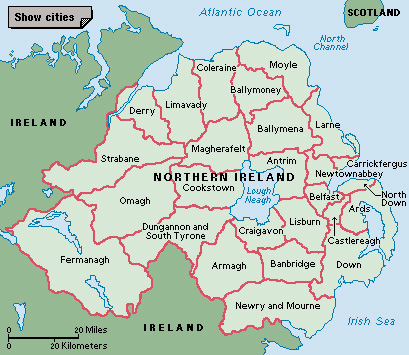Limavady << lih muh VA dee >> is a market town in northwestern Northern Ireland. Limavady stands just east of the River Roe. It is a few miles from the shores of Lough Foyle, an inlet of the Atlantic Ocean. The name Limavady comes from the Irish name Léim an Mhadaidh, which means leap of the dog. According to legend, a dog belonging to the ruling O’Cahan family leaped over the River Roe to deliver a message to allies during an enemy siege of the O’Cahan castle.
People have lived in the Limavady area for thousands of years. The Irish O’Cahan family ruled the region for many of the years from the 1100’s to the early 1600’s. The present town of Limavady dates from about 1610. In the early 1600’s, the English knight Thomas Phillips established a plantation—that is, a British Protestant settlement—in what became County Londonderry. Many families from Scotland and northern England came to the area. Limavady later became one of Ireland’s chief centers of linen production. Linen thread was made from flax grown on nearby farms.
Today, farmers in the rural areas near Limavady grow cereal grains, hay, and potatoes. They graze sheep on the hills and raise beef and dairy cattle. Limavady’s industries have traditionally included printing and the making of clothing, textiles, and whiskey. Mountain scenery, a beach, and a tourist complex near Limavady provide attractions for visitors.
Limavady stands in County Londonderry, one of Northern Ireland’s six historic counties. The county ceased to be used as an administrative area when a reorganization of local government divided it into smaller districts in 1973. Limavady was the name of a district council area—a kind of local government area—from 1973 to 2015. In 2015, the Ballymoney, Coleraine, Limavady, and Moyle districts were combined to form the Causeway Coast and Glens district.

